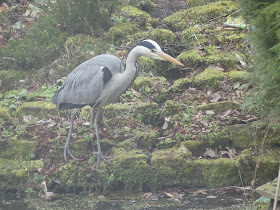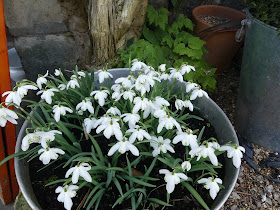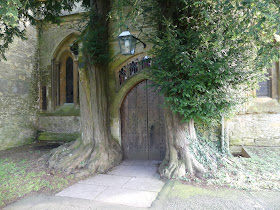A record of wildlife in my garden and various trips to the Warwickshire countryside and occasionally further afield.
Tuesday, 27 February 2018
A Grey Heron Visits the Garden Pond (Not for the Squeamish!)
Ever since B put in a garden pond we have had occasional visits from Grey Herons although they are usually very wary and rarely linger more than a few minutes.
Yesterday morning my daughter spotted one and, presumably because of hunger due to the cold weather and ice, this particular individual was far less wary than usual and ignored any sign of movements from the house so we were able to get good views.
The first few photos were taken through a rather dirty kitchen window!
So I moved upstairs where the bedroom window is a lot cleaner and watched the heron stalking round the pond.
We don't have fish in the pond just frogs and common newts and, as I had seen no sign yet of frogs moving around, I didn't think the heron would catch anything. I was wrong - its patience paid off and it obviously has much better eyesight than me as with one swift movement it removed a frog from the pond.
Warning! The next few photos are a bit graphic so if you are squeamish it might be best not to view the pictures.
The first frog
Swallowed!
And then it caught another one.
At this stage B, who is rather protective and proud of the amount of newts and frogs attracted by the pond, decided it was time he went a walk round the garden and the heron flew off. It did return several times during the course of the day but I didn't see it catch anything else.
Photos taken with the Panasonic Lumix FZ 330
Wednesday, 21 February 2018
A Visit to the Cotswolds - Part 2 : Stow-in-the-Wold and the Church of St Edward
After making a detour to see the Four Shires Stone we drove back to Moreton-in-Marsh and then onto Stow-in-the-Wold which is only a few miles away. It is the highest of the Cotswold towns located on Stow Hill at a height of 800 feet. At one time up to 20,000 sheep were sold at a time at sheep fairs held in the town. During the Battle of Stow in 1646 fighting continued into the town square and a local tale tells that blood flowed down Digbeth Street. William Smith, the "Father of English Geology" (born in 1769) learned land surveying at Stow-on-the-Wold.
It was even busier here than at Morton-in-Marsh but somehow we managed to again grab what was probably the one and only parking spot.
The square complete with cars and people!
The stocks are very old (sorry about the car and traffic cone).
The fountain was presented to the residents of Stow by Piers Thorsby Esquire in 1896.
I have been keen to visit Stow for some time since seeing a picture of the north door of the church on Twitter.
The church of St Edward
and here is the door
North Door framed by yews and said to have inspired JRR Tolkien especially in relation to the Gates of Moria.
Timothy insisted on having his photo taken at this point!
I am pretty sure the tombs in the photos below are examples of Bale tombs. These are found in the Cotswolds and date from the time when wealthy individuals had grown rich from the wool trade. The bale tomb has a ribbed semi-circular shape on top of the chest tomb. This may represent a a bale of wool or perhaps represent the rippled sheet of fabric (the pall) which covered the semi-circular metal frame (or hearse) erected over the body during medieval funeral services.
The church, a Grade 1 listed building, dates back to the 11th century (with additions from the 12th to 15th centuries) and stands on the site of an original wooden Saxon church. In 1645 during the Civil War 1500 of Sir Jacob Astley's troops were imprisoned in the church.
Although there were a few information boards and sheets in the church, I couldn't find a guide book, so I only have a small amount of information on the interior.
16th century font
Stained Glass
The War Memorial contains names of 45 men who died in World War One and 14 names were added after the Second World War
The inscription reads "To the sacred memory of the most illustrious leader "Hastings Keyt" Son of John Keyt Esquire of Ebrington in the County of Gloucestershire. Officer of the King's Worcestershire forces who fell in the battle near Stow 21st March, 1645."
Medieval corbels which were retained when the roof was rebuilt in the 19th century.
I could have spent a fortune in this book shop.
There is a plaque on the cross which reads" English Civil War Battle of Stow 21st March 1646. Near this cross Sir Jacob Astley surrendered to Parliamentary forces following defeat at the Battle of Stow. Some 200 Royalists were slaughtered in the square and 1500 imprisoned in the church overnight. This was final battle of the first Civil War leading to the end of the Royalist occupation of Oxford"
If you have a sweet tooth there are many shops to tempt you.
Timothy enjoying his visit.
And a few photos taken by D with the Canon bridge SX50
*D
*D
*D
*D
*D
I am not quite sure what this is on top of a chimney
*D










































































